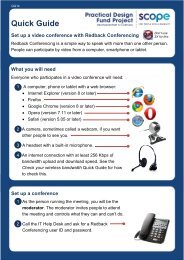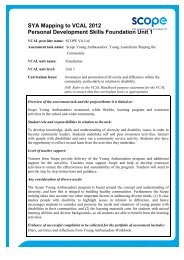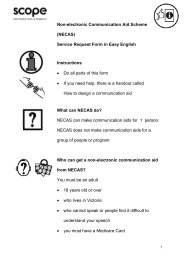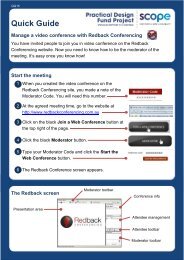Positive behaviour support Getting it right from the start
Positive behaviour support Getting it right from the start
Positive behaviour support Getting it right from the start
Create successful ePaper yourself
Turn your PDF publications into a flip-book with our unique Google optimized e-Paper software.
<strong>Pos<strong>it</strong>ive</strong> <strong>behaviour</strong> <strong>support</strong>: <strong>Getting</strong> <strong>it</strong> <strong>right</strong> <strong>from</strong> <strong>the</strong> <strong>start</strong> - Facil<strong>it</strong>ators reference manual 81<br />
PowerPoint 110<br />
*<br />
Every evening at 8.30 pm <strong>the</strong> staff member on duty said, ‘Andrea, <strong>it</strong>’s our discussion time. Come<br />
into <strong>the</strong> staff room and let me know what went wrong today.’ Then in a caring and genuine way,<br />
staff listened to what Andrea had to say. They always arranged <strong>the</strong> seats in a certain way and<br />
turned off <strong>the</strong> main light and turned on a reading lamp. At <strong>the</strong> end of ten minutes (if <strong>it</strong> was fair to<br />
end at this point) staff praised Andrea for sharing her complaints w<strong>it</strong>h <strong>the</strong>m.<br />
If Andrea made complaints during <strong>the</strong> day which didn’t need to be acted on <strong>the</strong>n, staff would say<br />
‘Andrea, remember that one for our discussion time tonight.’<br />
Steps involved in setting up a s<strong>it</strong>uational control program<br />
1. Select <strong>the</strong> target <strong>behaviour</strong><br />
2. Select an incentive to establish s<strong>it</strong>uational control (this may simply involve giving pos<strong>it</strong>ive<br />
feedback).<br />
3. Select a signal that <strong>the</strong> <strong>behaviour</strong> is OK now (select one which you control).<br />
Immediate response strategies<br />
<strong>Pos<strong>it</strong>ive</strong> Intervention Framework<br />
Proactive strategies<br />
What to do to prevent <strong>the</strong> <strong>behaviour</strong><br />
Immediate response<br />
strategies<br />
What might help when<br />
<strong>the</strong> <strong>behaviour</strong> occurs;<br />
beginning w<strong>it</strong>h least<br />
restrictive strategies?<br />
PowerPoint 111<br />
PowerPoint 112<br />
*<br />
*<br />
Change <strong>the</strong><br />
environment<br />
Teaching skills<br />
Introduce short-term<br />
change strategies<br />
for rapid change to<br />
<strong>behaviour</strong><br />
Ra<strong>the</strong>r than wa<strong>it</strong>ing for incidents to occur, <strong>it</strong>’s much wiser to be prepared. This is where<br />
immediate response strategies come in.<br />
Before <strong>the</strong>se strategies can be planned, <strong>it</strong> is imperative that <strong>the</strong> warning signs (precursors)<br />
to incidents of <strong>behaviour</strong> are identified. The warning signs are <strong>the</strong> <strong>behaviour</strong>s that <strong>the</strong> person<br />
engages in during <strong>the</strong> lead up to <strong>the</strong> actual <strong>behaviour</strong> (as opposed to triggers that are <strong>the</strong> setting<br />
events that occur immediately before <strong>the</strong> <strong>behaviour</strong>).<br />
Reactive strategies should be planned in a ‘hierarchical manner’, that is, <strong>the</strong>re should be a<br />
series of steps incorporated into <strong>the</strong> plan, which match <strong>the</strong> level of escalation that <strong>the</strong> person<br />
is displaying at any particular time. Steps should always reflect <strong>the</strong> principles of <strong>the</strong> ‘least<br />
restrictive alternative’ ranging <strong>from</strong> <strong>the</strong> least to <strong>the</strong> most restrictive strategies. If a restrictive<br />
intervention is to be used <strong>the</strong> option chosen should be <strong>the</strong> least restrictive as possible in <strong>the</strong><br />
circumstances (s 140 (b) Disabil<strong>it</strong>y Act 2006).

















